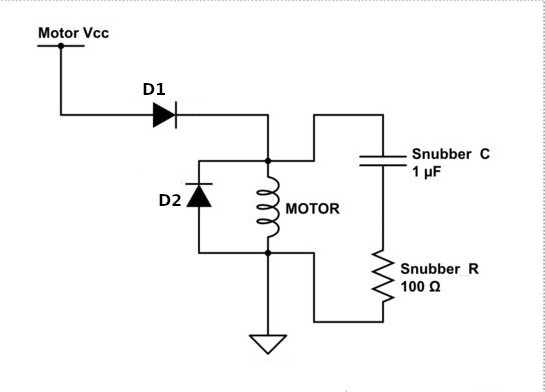The Snubber Circuit
The diagram below is the circuit I came up with. It is what is known as a snubber circuit along with two diodes. Diodes D1 and D2 are 10 amp Schottky diodes with a PIV of 50 volts. Since my DC motor draws 6 amps while running, and the Schottky diodes are what I had on hand, that is what I used.

Diode D1 insures that all current flows in the proper direction and keeps all voltage spikes that aren’t completely suppressed from back-feeding into my off-grid solar system. Diode D2 is a flyback diode which suppresses the sudden voltage spike from the DC motor when power is removed.
Capacitor Snubber C is two 2 uf electrolytic capacitors in series. A snubber capacitor needs to be able to suppress DC voltage spikes in both the positive as well as the negative direction. However electrolytic capacitors are polarized, that is the positive voltage needs to be applied to the + lead of the electrolytic capacitor and the negative voltage needs to be applied to the – lead of the electrolytic capacitor.
So in order to make a non-polarized capacitor out of an electrolytic, you simply take two capacitors that are double the desired value and connect the two negative leads together. Then just consider these two capacitors as one and place it in the circuit as shown.
Here is a diagram on how to make two polarized electrolytic capacitors into one non-polarized electrolytic:

As you can see in the diagram above, there are two 2 uF capacitors in series. When you put two capacitors in series, the resultant capacitance is half the value of one capacitor. So in this case, the net, or final value of our non-polarized capacitor is 1 uF. So in the circuit diagram above, just treat these two capacitors as one capacitor and you are good to go.
One more thing I did after adding this snubber circuit to my DC motor, I also added a couple of ferrite beads and wrapped the wire several times through the ferrite core. Basically I had them laying around so I wen ahead and installed them.
The values I used for this snubber circuit are by no means based on any engineering on my part. This is based on what I have seen and what I had in my parts bin. For my application it seems to work fine. As they say though, your mileage may vary.
73’s
— Mike WB8ERJ
Leave a Reply